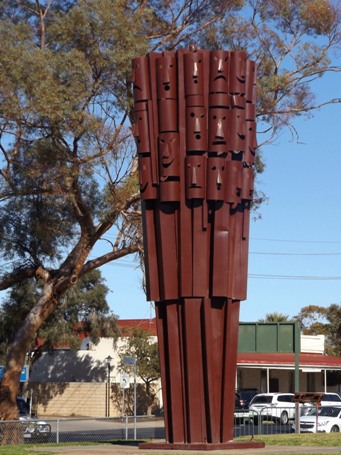Australia So Much to See


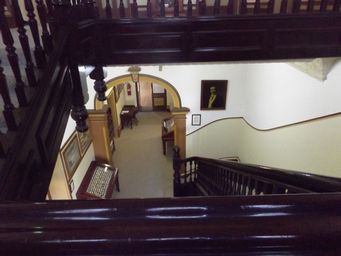
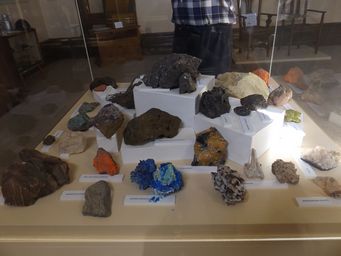
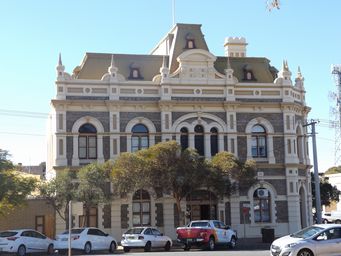
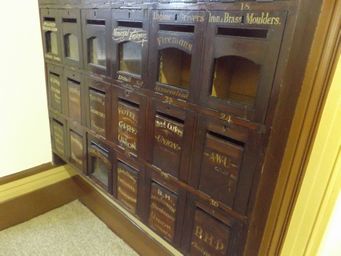
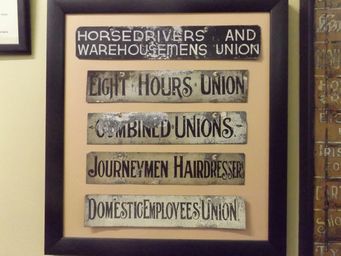
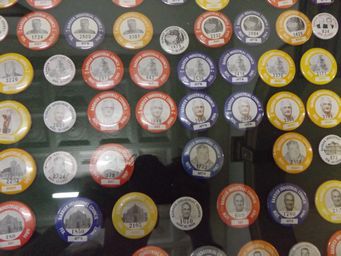
Broken Hill, New South Wales - history, mining and art
Broken Hill's population peaked at around 30,000 in the early 1960s and has shrunk by one third since the heyday of the 1970s zinc boom, with the decrease attributed to migration from the closure and consolidation of mining operations. The estimated urban population of Broken Hill at the 2016 census was 17,814, a 5% reduction from 18,777 in 2011.
At a time when number of pubs rather
than population was recorded to indicate the size of mining towns, in 1892 Broken Hill was said to have 63 hotels plus a number of
licenced clubs. There were also a number of hotels or wayside inns in close proximity to the town. By 1969 the per capita
consumption of beer in Broken Hill was stated as four times the South Australian state average. Note below that Broken Hill residents
have more in common with South Australia then their own state of New South Wales. Reference: Barrier Hill Daily Truth newspaper
archives. Many former corner hotel buildings are still standing and used for other purposes and only twelve licensed hotels
remain, plus nine licensed clubs and associations.
This small city is isolated in the far west of the state. The distance from Broken Hill to Sydney is more than twice as far as Broken Hill to Adelaide. So Broken Hill people identify more with South Australians, and go to Adelaide for specialist medical treatment and for a larger variety of shops and businesses. Broken Hill time zone is aligned to South Australia, not to the rest of New South Wales. The South Australian regional television company, Southern Cross, also transmits to Broken Hill. Many Broken Hill residents support the two Adelaide football teams. This is all the more significant to them with Adelaide Crows Captain Taylor Walker being from Broken Hill. The closest town for a larger variety of shops and businesses is also interstate, in Victoria, at Mildura.
Even Melbourne is 300 kilometres closer
by road than Sydney.
Like many "outback" towns, Broken Hill was built on precious metals, having once had the world's
richest deposits of lead, zinc and silver. Although now depleted somewhat, mining still yields around two million tonnes annually.
Some mine tours are available. Sheep farming is now one of the principal industries in the area and there are considerably more sheep
than people with almost two million Merino sheep.
Ref: Wikipedia
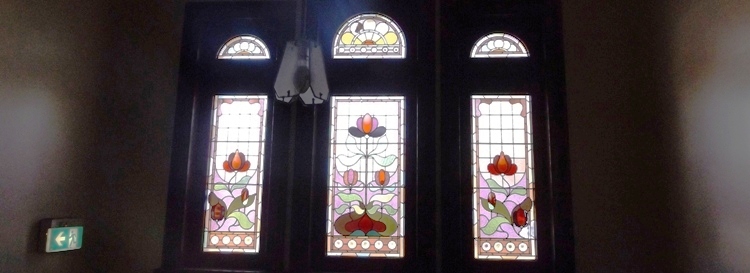
Broken Hill is also known for its input into the formation of the labour movement in Australia, and has a rich trade union history.
Some of the most bitter industrial disputes were fought in Broken Hill in 1892, 1909 and 1919. It lasted from May 1919 until November
1920 and involved thousands of mine workers and their families who struggled to survive, mainly on rations of potatoes, onions and
jam.
During the "Great Strike" cooperative depots were
established by the unions, supplying housewives with basic food such as bread, potatoes and onions. Many mothers saw their children
suffer from malnutrition. Miscarriages due to poor diet and anxiety were common.
During the five month long 1909 BHP Lockout,
which remains one of the most celebrated and bitterly fought battles in Australian labour history, women formed a Relief Committee
to help those struggling to feed and clothe their families. The women of Broken Hill played a pivotal role in the strikes which shaped
the unique industrial history of the city, offering physical and moral support to their mining fathers, husbands, brothers and sons.
Women
enforced a policy in the shops and pubs of not serving “scab” workers and police, while organising a coupon system for strikers, in
exchange for time served on the picket lines. Buttons were given to all townspeople who were in the union or supported the strike
and those seen without them were often challenged.
The “Great Strike” finally ended in November 1920 after both the unions and
mine managers agreed to the recommendation made by the President of the New South Wales Industrial Court, Justice Edmunds. Among
the concessions, miners were awarded improved safety conditions, better health monitoring and – for the first time in Australia –
a 35-hour working week.
For over fifty years, union policy in Broken Hill prohibited married women from taking on paid employment unless they were professionally trained. Clerical and retail positions were to be kept open for young unmarried women or widows.
By the mid 1920s Broken Hill had become a fully unionised city and all workers, whether they worked on the mines or in town, had to have an 'O.K.', or union ticket, to be eligible for employment. Union tickets were distributed by the powerful peak union body, the Barrier Industrial Council. With the exception of the six years during World War Two when the bar on married women was lifted, the Barrier Industrial Council excluded women from paid employment after they married. The policy was intended to encourage young women to stay in Broken Hill by ensuring that there were positions available for them when they left school.
An article in the Barrier Miner in March 1957 explained the policy as an attempt to 'combat the difficulty of girls leaving school and struggling to find work'. The article also described the three-point-plan devised and adopted by the union: employers were requested not to offer employment to married women; to dismiss women if they married and make their position available for a single girl; and to put off married women first in cases of retrenchment. Teachers and other professionally trained married women were allowed to continue working on condition that there were no qualified single women available for the role. Women working in unskilled or low-skilled professions such as shop assistants, receptionists and domestic staff would lose their jobs upon marriage.
In 1981 Jeanine Clarke formally and successfully challenged union policy in Broken Hill preventing married women from working
in certain professions. She was the first woman to do so.
Jeanine Clarke was born and raised in Broken Hill. Both parents were
heavily involved with local voluntary organisations. After completing year eleven at Broken Hill High School, Jeanine began training
as a dental nurse with the Town Dental Clinic and was awarded her dental assistant certificate. When she married her high school sweetheart
in 1980, she was employed as the most senior of five dental assistants at the Town Dental Clinic.
Jeanine was told by her employers that she would have to resign. She refused, and was dismissed in July 1981. Seeking advice from the Anti-Discrimination Board established under premier Neville Wran, Jeanine was assisted by Carmel Niland (Councillor for Equal Opportunity), Irene Moss and June Williams. She took her case to the Sydney courts and by December 1981 had been reinstated.
Though Jeanine lodged her case against her
employer, the Town Dental Clinic, the result was an overturning of broader union policy long enforced by the Barrier Industrial Council
of Broken Hill that had prohibited many married women from working. The policy had been designed in theory to protect the Broken Hill
community, but by 1981 was outdated, arbitrary in its administration (professionally trained women were exempt) and based upon an
inaccurate assumption that all married women wanted to be at home raising a family. Jeanine's case opened the way for many women to
marry without fear of dismissal.
This was a landmark case which not only engendered a significant shift in the nature of women's
employment in Broken Hill, but also signalled the beginnings of the erosion of the power of the Barrier Industrial Council.
References:Trove
Kintore Reserve in the centre of Broken Hill features the wooden Kintore Mine headframe, dating back to the 1800s, which was moved here in 1984. The winding drum came from the North Mine. There is other mining equipment on display as well as two Pro Hart sculptures.
Ref: ABC Kintore Reserve
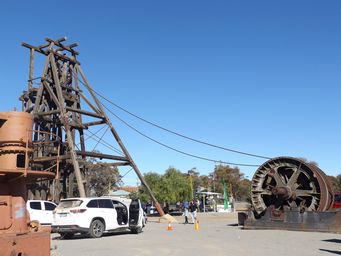
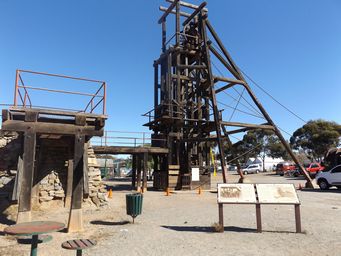
The strip of land between Blende and Beryl Streets was reserved for a tramway in 1887. The Silverton Tramway Company's workshops
were located at Railway town, and the line continued north along Beryl Street, servicing warehouses.
The Sulphide Street Railway and Historical Museum Complex houses the Silverton Tramway Company locomotives, and memorabilia in the original stone railway station building of the Silverton Tramway Company of 1905. The Broken Hill Migrant Heritage Museum, Hospital Museum, Ron Carter Transport Pavilion and the Tess Alfonsi Mineral Collection from the Triple Chance Mine are all on site. The Railway Museum houses the original stone railway station building of the Silverton Tramway Company of 1905.
References: Australian Museums and Galleries
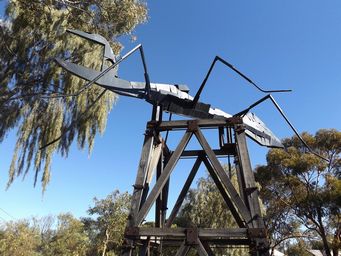
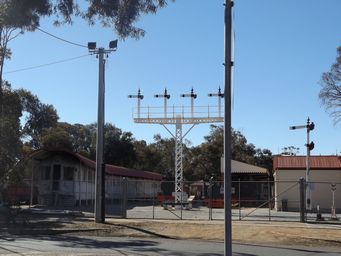
Nearby is another Pro Hart sculpture, “End of Shift”, with faces depicting the many moods of workers ascending from the mine after
their work shift. At left.
Pro Hart Ant sculpture. The sculpture is inscribed with the words: “Dedicated to the workers of Broken Hill and their struggles to extract the wealth we all live from.” Below.
The Silver City Comet was a train service that operated from September 1937 until November 1989 It was the became the first lightweight,
fully airconditioned, diesel powered train in Australia, and the first airconditioned train in the British Empire. Five power cars
were built to provide the Silver City Comet service.
In September 1937 the Silver City Comet rail service commenced operating
three times a week between Parkes and Broken Hill. From January 1957, Silver City Comet stock operated three times per week
service from Parkes to Orange and Dubbo. The Silver City Comet had provided 52 years of service from 1937 to November 1989.
An original power car plus four carriages is on display in the Sulphide Street Museum.
References: Wikipedia
